Using Inserts in Thermoset Molding
Using Inserts in Thermoset Molding
Injection molders and OEMs have been using various styles of inserts in their plastic parts and product applications to mechanically fasten separate components together for quite some time. Thermoset molded parts are no different. Depending on the application type, environment the application is used in, and geometries of the molded parts, there are many options to using inserts in a product design. Inserts can be molded-in during the molding cycle or tapped/press-fit into the part after molding. Where a part with complex geometries may have very high tooling costs or a high scrap/fallout rate during molding, inserts can be used to fasten and secure multiple parts together without molding the application into a single part. Additionally, inserts may be used as a heat sink or grounding mechanism for protection and safe handling of electrical and lighting products.

Molded-In Threaded Insert
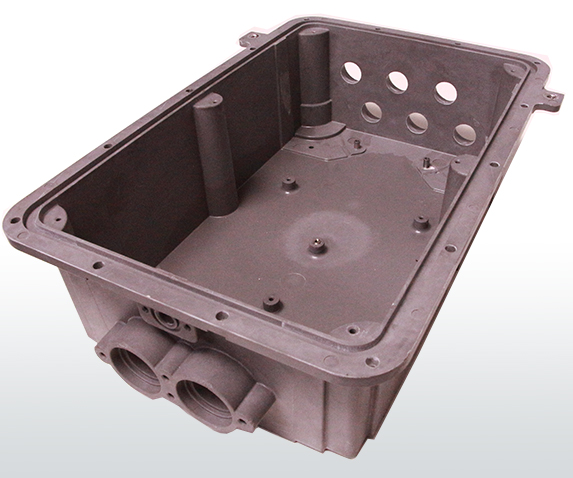
Entire Molded Part with Molded-In Insert in Middle
Types of Inserts in Thermoset Molding
The most common type of insert used in thermoset molding is a threaded insert. Threaded inserts are threaded on the ID to allow a second component or item to fasten together. Threaded inserts can be press-fit after molding, driven into a drilled or cored out hole with a driver, or can also be molded-in during the molding operation. Inserts may be threaded or knurled on the OD to keep the insert in place and allow the polymer to encapsulate it in molded-in applications.
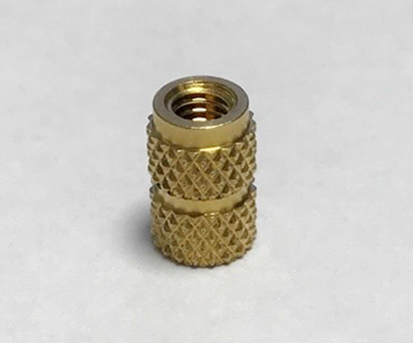
Knurled Brass Threaded Insert
Press Fit Inserts
Advantages of press-fit inserts are they are quick to assemble and generally do not require additional installation equipment. Although press-fit inserts may be more cost effective and quicker to install, they also have less torque rating and a higher chance of coming loose or being pulled out of the part or application. Press-fit inserts are not recommended for applications that may be at risk if the insert is damaged or pulled out due to the lower torque and strength.
Self-Tapping Inserts
Self-tapping inserts, or inserts that are driven mechanically into an existing core or drilled hole, are much more stable than press-fit inserts; however they require minor equipment such as a drill or driver to mechanically drive the inserts into the part, cutting its own threads. Additionally, self-tapping inserts may have longer cycle times or installation duration than simple press-fit inserts. Trisert® inserts are a common type of self-tapped threaded insert.
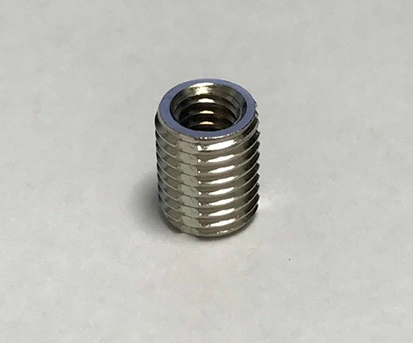
Self-Tapped Nickel Plated Brass Insert
Molded-In Inserts
Molded-in threaded inserts are the most stable of the options. Molded-in inserts are pressed into a mold prior to molding operation. During the molding operation, the plastic polymer encapsulates the insert to set it in place. Molded-in inserts do not require a secondary operation to drive the inserts or press fit them in, however they must be loaded either by hand or with automation prior to the molding cycle. As with both thermoset molding and thermoplastic molding, consistent cycle times are important to produce acceptable parts with insert molding. Additionally, the mold must be designed property to ensure a correct shut off on the insert so the plastic material does not enter the internal threads, otherwise the threads will need to be cleaned out in a secondary operation.

Molded-In Threaded Brass Insert
Alternative Uses of Inserts
In some electronic or lighting applications, inserts have been used as an added heat sink to the product application. While most thermoset materials are known as insulators, molded-in aluminum inserts can act as a conductive heat sink in the application to draw out excess heat and keep internal electrical components safe from high temperatures. Another alternative use of inserts used in electrical enclosure applications are for electrical grounding purposes. Designers can implement inserts or brackets in electrical applications for grounding purposes to eliminate the risk of electric shock or dangerous voltage levels for handlers, installers, and end-users. In pulley applications, inserts can be used as bearings to reduce load and fatigue.
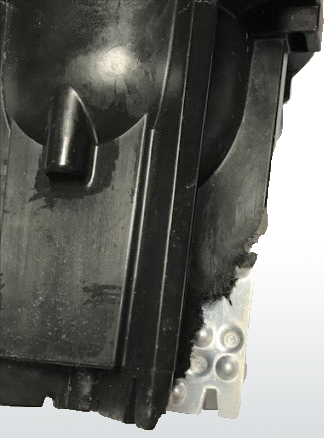
Molded-In Aluminum Insert Used as Heat Sink (short shot shown above)
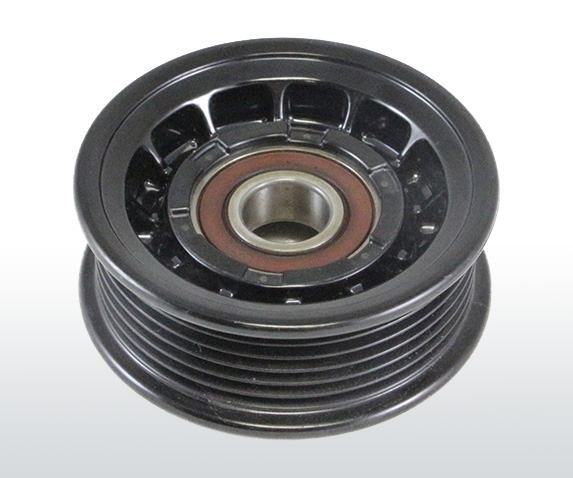
Automotive Pulley with Bearing Insert
Material Types of Inserts
Common insert material types include aluminum, brass, and stainless steel. Each material has its own benefits and advantages, however it is important to choose the right insert material for your application. Aside from the raw material; brass inserts, for example, can also be plated with nickel for added lubricity or corrosion resistance.
The most cost-effective insert material is aluminum, which is also lightweight compared to brass or stainless steel. While aluminum inserts are the lowest cost option for inserts, they are not always recommended with thermosets. Aluminum inserts are prone to corrode in applications exposed to moisture, water, or other liquids, and also may degrade when exposed to certain chemicals.
Brass inserts are heavier than aluminum; however offer much better corrosion resistant properties than aluminum. Brass inserts are generally a more expensive than aluminum inserts, however offer much better material property performance and are also much lower cost than stainless steel, which is also corrosion resistant.
Stainless steel inserts can be considered the Cadillac of inserts, and the costs for stainless steel inserts represent that as well. Stainless steel inserts generally have a much higher cost than brass or aluminum; however they offer the best strength properties and are highly resistant to moisture, corrosion and exposure to chemicals or oils.



Comments are closed